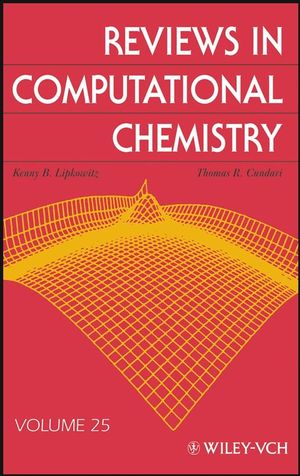Reviews in Computational Chemistry, Volume 25ISBN: 978-0-470-17998-7
Hardcover
448 pages
October 2007
 |
||||||
Introduction.
Phenomenology of the Glass Transition.
Model Building.
Chemically Realistic Modeling.
Coarse-Grained Models.
Coarse-Grained Models of the Bead-Spring Type.
The Bond-Fluctuation Lattice Model.
Simulation Methods.
Monte Carlo Methods.
Molecular Dynamics Method.
Thermodynamic Properties.
Dynamics in Super-Cooled Polymer Melts.
Dynamics in the Bead-Spring Model.
Dynamics in 1,4-Polybutadiene.
Dynamic Heterogeneity.
Summary.
Acknowledgments.
References.
2. Atomistic Modeling of Friction (Nicholas J. Mosey and Martin H. Muser).
Introduction.
Theoretical Background.
Friction Mechanisms.
Load-Dependence of Friction.
Velocity-Dependence of Friction.
Role of Interfacial Symmetry.
Computational Aspects.
Surface Roughness.
Imposing Load and Shear.
Imposing Constant Temperature.
Bulk Systems.
Computational Models.
Selected Case Studies.
Instabilities, Hysteresis, and Energy Dissipation.
The Role of Atomic-Scale Roughness.
Superlubricity.
Self-Assembled Monolayers.
Tribochemistry.
Concluding Remarks.
Acknowledgments.
References.
3. Computing Free Volume, Structural Order, and Entropy of Liquids and Glasses (Jeetain Mittal, William P. Krekelberg, Jeffrey R. Errington, and Thomas M. Truskett).
Introduction.
Metrics for Structural Order.
Crystal-Independent Structural Order Metrics.
Structural Ordering Maps.
Free Volume.
Identifying Cavities and Computing Their Volumes.
Computing Free Volumes.
Computing Thermodynamics from Free Volumes.
Relating Dynamics to Free Volumes.
Entropy.
Testing the Adam–Gibbs Relationship.
An Alternative to Adam–Gibbs?
Conclusions.
Acknowledgments.
References.
4. The Reactivity of Energetic Materials at Extreme Conditions (Laurence E. Fried).
Introduction.
Chemical Equilibrium.
Atomistic Modeling of Condensed-Phase Reactions.
First Principles Simulations of High Explosives.
Conclusions.
Acknowledgments.
References.
5. Magnetic Properties of Atomic Clusters of the Transition Elements (Julio A. Alonso).
Introduction.
Basic Concepts.
Experimental Studies of the Dependence of the Magnetic Moments with Cluster Size.
Simple Explanation of the Decay of the Magnetic Moments with Cluster Size.
Tight Binding Method.
Tight Binding Approximation for the d Electrons.
Introduction of s and p Electrons.
Formulation of the Tight Binding Method in the Notation of Second Quantization.
Spin-Density Functional Theory.
General Density Functional Theory.
Spin Polarization in Density Functional Theory.
Local Spin-Density Approximation (LSDA).
Noncollinear Spin Density Functional Theory.
Measurement and Interpretation of the Magnetic Moments of Nickel Clusters.
Interpretation Using Tight Binding Calculations.
Influence of the s Electrons.
Density Functional Calculations for Small Nickel Clusters.
Orbital Polarization.
Clusters of Other 3d Elements.
Chromium and Iron Clusters.
Manganese Clusters.
Clusters of the 4d Elements.
Rhodium Clusters.
Ruthenium and Palladium Clusters.
Effect of Adsorbed Molecules.
Determination of Magnetic Moments by Combining Theory and Photodetachment Spectroscopy.
Summary and Prospects.
Appendix. Calculation of the Density of Electronic States within the Tight Binding Theory by the Method of Moments.
Acknowledgments.
References.
6. Transition Metal- and Actinide-Containing Systems Studied with Multiconfigurational Quantum Chemical Methods (Laura Gagliardi).
Introduction.
The Multiconfigurational Approach.
The Complete Active Space SCF Method.
Multiconfigurational Second-Order Perturbation Theory, CASPT2.
Treatment of Relativity.
Relativistic AO Basis Sets.
The Multiple Metal–Metal Bond in Re2Cl2-8 and Related Systems.
The Cr–Cr Multiple Bond.
Cu2O2 Theoretical Models.
Spectroscopy of Triatomic Molecules Containing One Uranium Atom.
Actinide Chemistry in Solution.
The Actinide–Actinide Chemical Bond.
Inorganic Chemistry of Diuranium.
Conclusions.
Acknowledgments.
References.
7. Recursive Solutions to Large Eigenproblems in Molecular Spectroscopy and Reaction Dynamics (Hua Guo).
Introduction.
Quantum Mechanics and Eigenproblems.
Discretization.
Direct Diagonalization.
Scaling Laws and Motivation for Recursive Diagonalization.
Recursion and the Krylov Subspace.
Lanczos Recursion.
Exact Arithmetic.
Finite-Precision Arithmetic.
Extensions of the Original Lanczos Algorithm.
Transition Amplitudes.
Expectation Values.
Chebyshev Recursion.
Chebyshev Operator and Cosine Propagator.
Spectral Method.
Filter-Diagonalization.
Filter-Diagonalization Based on Chebyshev Recursion.
Low-Storage Filter-Diagonalization.
Filter-Diagonalization Based on Lanczos Recursion.
Symmetry Adaptation.
Complex-Symmetric Problems.
Propagation of Wave Packets and Density Matrices.
Applications.
Bound States and Spectroscopy.
Reaction Dynamics.
Lanczos vs. Chebyshev.
Summary.
Acknowledgments.
References.
8. Development and Uses of Artificial Intelligence in Chemistry (Hugh Cartwright).
Introduction.
Evolutionary Algorithms.
Principles of Genetic Algorithms.
Genetic Algorithm Implementation.
Why Does the Genetic Algorithm Work?
Where Is the Learning in the Genetic Algorithm?
What Can the Genetic Algorithm Do?
What Can Go Wrong with the Genetic Algorithm?
Neural Networks.
Neural Network Principles.
Neural Network Implementation.
Why Does the Neural Network Work?
What Can We Do with Neural Networks?
What Can Go Wrong?
Self-Organizing Maps.
Where Is The Learning?
Some Applications of SOMs.
Expert Systems.
Conclusion.
References.
Author Index.
Subject Index.



